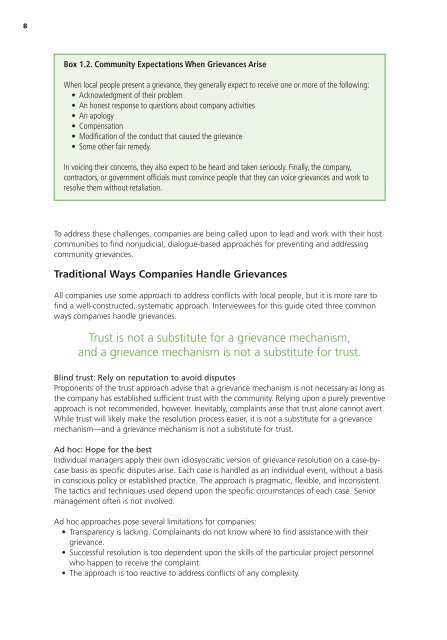A Guide to Designing and Implementing Grievance Mechanisms for ...
A Guide to Designing and Implementing Grievance Mechanisms for ...
A Guide to Designing and Implementing Grievance Mechanisms for ...
You also want an ePaper? Increase the reach of your titles
YUMPU automatically turns print PDFs into web optimized ePapers that Google loves.
8<br />
Box 1.2. Community Expectations When <strong>Grievance</strong>s Arise<br />
When local people present a grievance, they generally expect <strong>to</strong> receive one or more of the following:<br />
• Acknowledgment of their problem<br />
• An honest response <strong>to</strong> questions about company activities<br />
• An apology<br />
• Compensation<br />
• Modification of the conduct that caused the grievance<br />
• Some other fair remedy.<br />
In voicing their concerns, they also expect <strong>to</strong> be heard <strong>and</strong> taken seriously. Finally, the company,<br />
contrac<strong>to</strong>rs, or government officials must convince people that they can voice grievances <strong>and</strong> work <strong>to</strong><br />
resolve them without retaliation.<br />
To address these challenges, companies are being called upon <strong>to</strong> lead <strong>and</strong> work with their host<br />
communities <strong>to</strong> find nonjudicial, dialogue-based approaches <strong>for</strong> preventing <strong>and</strong> addressing<br />
community grievances.<br />
Traditional Ways Companies H<strong>and</strong>le <strong>Grievance</strong>s<br />
All companies use some approach <strong>to</strong> address conflicts with local people, but it is more rare <strong>to</strong><br />
find a well-constructed, systematic approach. Interviewees <strong>for</strong> this guide cited three common<br />
ways companies h<strong>and</strong>le grievances.<br />
Trust is not a substitute <strong>for</strong> a grievance mechanism,<br />
<strong>and</strong> a grievance mechanism is not a substitute <strong>for</strong> trust.<br />
Blind trust: Rely on reputation <strong>to</strong> avoid disputes<br />
Proponents of the trust approach advise that a grievance mechanism is not necessary as long as<br />
the company has established sufficient trust with the community. Relying upon a purely preventive<br />
approach is not recommended, however. Inevitably, complaints arise that trust alone cannot avert.<br />
While trust will likely make the resolution process easier, it is not a substitute <strong>for</strong> a grievance<br />
mechanism—<strong>and</strong> a grievance mechanism is not a substitute <strong>for</strong> trust.<br />
Ad hoc: Hope <strong>for</strong> the best<br />
Individual managers apply their own idiosyncratic version of grievance resolution on a case-bycase<br />
basis as specific disputes arise. Each case is h<strong>and</strong>led as an individual event, without a basis<br />
in conscious policy or established practice. The approach is pragmatic, flexible, <strong>and</strong> inconsistent.<br />
The tactics <strong>and</strong> techniques used depend upon the specific circumstances of each case. Senior<br />
management often is not involved.<br />
Ad hoc approaches pose several limitations <strong>for</strong> companies:<br />
• Transparency is lacking. Complainants do not know where <strong>to</strong> find assistance with their<br />
grievance.<br />
• Successful resolution is <strong>to</strong>o dependent upon the skills of the particular project personnel<br />
who happen <strong>to</strong> receive the complaint.<br />
• The approach is <strong>to</strong>o reactive <strong>to</strong> address conflicts of any complexity.





